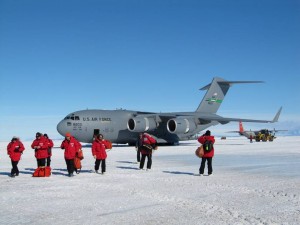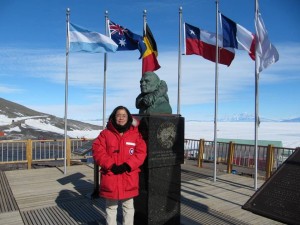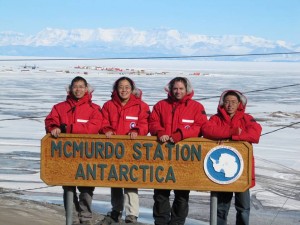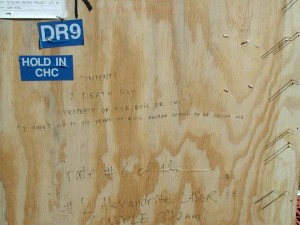Once again I am on the ice. It is my 5th trip to the Antarctic, and also the beginning of our new lidar campaign at the USAP (United States Antarctic Program) McMurdo Station (77.85S, 166.67E). The purpose is to complete an observational chain for Antarctica in combination with previous lidar measurements made at the South Pole (90S) and Rothera (67.5S, 68.0W), Antarctica.

The C-17 (with four jet engines) as we got off at McMurdo. A C-130 airplane (with four propellers) was in the background.
After flying from Denver to Christchurch, New Zealand via Los Angeles and Auckland, we started our journey to McMurdo, Antarctica on November 17th, 2010. The C-17 US Air Force airplane took off from Christchurch International Airport at 10am in the morning, and arrived in McMurdo ice runway by 3pm in the afternoon. It was a smooth 5-hour flight. Since the C-17 was much larger compared to previous C-130 airplane I flew, we had relatively comfortable seating and space to walk around. We even had opportunities to talk to the pilots. I took a photo of the C-17 (with four jet engines) after I got off at McMurdo (see below). A C-130 airplane (with four propellers) was in the background. In the photo, you can also get a sense of what ECW (Extremely Cold Weather) gear looks like.
McMurdo is a coastal station built on the bare volcanic rock of the Hut Point Peninsula on Ross Island, the farthest south solid ground that can be accessed by ship. According to the McMurdo intranet, the station is roughly 3,864 km (2,415 miles) south of Christchurch, New Zealand, and 1,360 km (850 miles) north of the South Pole. Temperatures have been as low as –50°C (–58°F) and as high as 8°C (46°F). The annual mean is –18°C (0°F); monthly mean temperatures range from minus –3°C (27°F) in January to –28°C (–18°F) in August.
When we arrived the station’s population was approaching its peak: 1064 people. The population then quickly jumped to 1200 people on the following a few days. Housing and DNF (Do Not Freeze) storage were both at their peak capacities. We heard some people had to sleep on the floor of the gym. Fortunately, we as US grantees were treated quite nicely, and we got nice rooms in the Building 201, although internet wasn’t available there.
We had to go through many briefings and orientations as USAP wants to ensure our safety in Antarctica. During the arrival briefing, I was given a folder for our A-130 project that contained a vast amount of information including many contact numbers. We were a little bit overwhelmed. On the 2nd day, Nov. 18, 2010, we had a science in-brief with NSF science representative Lisa Clough and various McMurdo Station managers and science support team leaders. Again, we were overwhelmed information, but we felt their warm hearts and their concern for science!
As space is really precious at McMurdo due to over-population, office allocations are very tight. However, the Crary Lab science manager was able to give us a temporary office space in Crary Lab 238 from Nov. 17 to Dec. 4, and then a formal office in Crary office 116 from Dec. 4th to the end of the 2010-2011 season. We certainly appreciate this arrangement.
This McMurdo lidar project, funded by NSF Office of Polar Programs (OPP), is a collaboration between USAP and New Zealand Antarctic Program (ANZ), as we are going to install our upgraded Fe Boltzmann lidar into the Kiwi’s laboratory at Arrival Heights. Both USAP and ANZ people have been working very hard to modify the lab in order to host our lidar. Unfortunately, the constructions are not done yet, so we need to wait for some time. But we came in at a perfect time as the American electricians and Kiwi carpenters wanted to get our exact answers to several technical questions they had. This was accomplished on Friday, Nov. 19th, 2010 when Dave Nelson (the science support lead of McMurdo Station) brought me and Wentao to Arrival Heights to meet construction people from both sides. After that things were progressing fast in the construction.
In the meantime, Wentao and I drew the first lidar footprint on the floor of Arrival Heights Lab C after our careful considerations of the lidar setup and the roof hatch positions. All cargo crates look very nice sitting in the DNF space of Building 132. We are going to deal with cargo in the following week.
As the PI of this A-130 lidar project, what I am really proud of is the team I brought to Antarctica this time. The current members on station are in the photo of below. We have two more team members coming – Mr. Zhibin Yu who is going to be the winter-over scientist and Dr. Chet Gardner who is the co-PI of this project. Our senior collaborator Dr. Adrian McDonald will come on January 12, 2011, he shares the Arrival Heights lab with us.
The world is small sometimes! When we asked a neighbor in Lab 238 to take group photos for us, it turns out this gentleman is Robbie Bauer from CIRES, who works at NSIDC on the east campus! It is a happy CIRES reunion in Antarctica!
Of course, working in McMurdo we must pay respect to Richard Byrd who was the first to fly over both the North Pole and the South Pole in 1920s.
 A major change of McMurdo from 10 years ago when I passed through it on the way to and from the South Pole is the wind turbines that are generating electricity to supply Scott Base (NZ station) and partially supply McMurdo’s energy needs.
A major change of McMurdo from 10 years ago when I passed through it on the way to and from the South Pole is the wind turbines that are generating electricity to supply Scott Base (NZ station) and partially supply McMurdo’s energy needs.
At the end of this first journey report, I would like to tell you a little history story. My colleague Dr. Chet Gardner and I built several powerful lidars in the past, and one of them — the Fe Boltzmann lidar — was deployed to the South Pole from 1999 to 2001.

An old photo from 2001 taken at the South Pole when the carpenters wrote “Evil Dr. Chu” on my bunny boots.
Unfortunately, this lidar wasn’t energy efficient and required quite some electrical power. So at the Pole we ran into some power issues. Somehow, two carpenters (Gary and Jennifer), who were good friends of mine and helped us quite a bit in the lidar project, started to call me “Evil Dr. Chu”, an analogy to some American movie character who wanted to use laser to take over the world, or something similar. I found an old photo from 2001 taken at the South Pole when the carpenters wrote “Evil Dr. Chu” on my bunny boots. Another interesting photo was taken in 2002 at Cambridge after our lidar was shipped from the South Pole to UK and our British colleagues Dr. Patrick Espy, Dr. Graeme Nott and D.J. Maxfield found the sentences written on one of the crates by the carpenters. While McMurdo folks are feeling that the A-130 project has really nice scientists and PhD students, they don’t know yet that “Evil Dr. Chu has come to Antarctica!”
All the best wishes from Antarctica — may your days light up with sunshine and the spirit of adventure!
Sincerely,
Xinzhao


